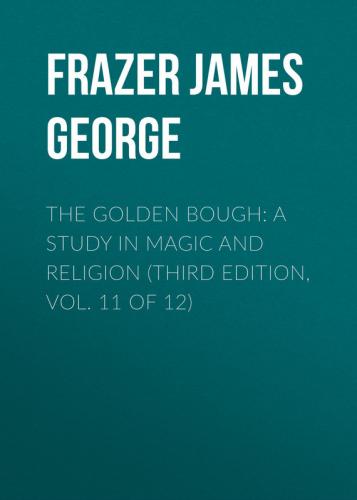various hands, vol. ii. translated by W. H. D. Rouse (Cambridge, 1895), pp. 111
sq.
334
G. W. Leitner, The Languages and Races of Dardistan, Third Edition (Lahore, 1878), p. 9.
335
Apollodorus, Bibliotheca, i. 8; Diodorus Siculus, iv. 34; Pausanias, x. 31. 4; Aeschylus, Choeph. 604 sqq.; Antoninus Liberalis, Transform. ii.; Dio Chrysostom, Or. lxvii. vol. ii. p. 231, ed. L. Dindorf (Leipsic, 1857); Hyginus, Fab. 171, 174; Ovid, Metam. viii. 445 sqq. In his play on this theme Euripides made the life of Meleager to depend on an olive-leaf which his mother had given birth to along with the babe. See J. Malalas, Chronographia, vi. pp. 165 sq. ed. L. Dindorf (Bonn, 1831); J. Tzetzes, Scholia on Lycophron, 492 sq. (vol. ii. pp. 646 sq., ed. Chr. G. Müller, Leipsic, 1811); G. Knaack, “Zur Meleagersage,” Rheinisches Museum, N. F. xlix. (1894) pp. 310-313.
336
Apollodorus, Bibliotheca, iii. 15. 8; Aeschylus, Choeph. 612 sqq.; Pausanias, i. 19. 4; Ciris, 116 sqq.; Ovid, Metam. viii. 8 sqq. According to J. Tzetzes (Schol. on Lycophron, 650) not the life but the strength of Nisus was in his golden hair; when it was pulled out, he became weak and was slain by Minos. According to Hyginus (Fab. 198) Nisus was destined to reign only so long as he kept the purple lock on his head.
337
Apollodorus, Bibliotheca, ii. 4. 5 and 7.
338
J. G. von Hahn, Griechische und albanesische Märchen (Leipsic, 1864), i. 217; a similar story, ibid. ii. 282.
339
B. Schmidt, Griechische Märchen, Sagen und Volkslieder (Leipsic, 1877), pp. 91 sq. The same writer found in the island of Zacynthus a belief that the whole strength of the ancient Greeks resided in three hairs on their breasts, and that it vanished whenever these hairs were cut; but if the hairs were allowed to grow again, their strength returned (B. Schmidt, Das Volksleben der Neugriechen, Leipsic, 1871, p. 206). The Biblical story of Samson and Delilah (Judges xvi.) implies a belief of the same sort, as G. A. Wilken abundantly shewed in his paper, “De Simsonsage,” De Gids, 1888, No. 5 (reprinted in his Verspreide Geschriften, The Hague, 1912, vol. iii. pp. 551-579).
340
J. G. von Hahn, op. cit. ii. 215 sq.
341
Ibid. ii. 275 sq. Similar stories, ibid. ii. 204, 294 sq. In an Albanian story a monster's strength is in three pigeons, which are in a hare, which is in the silver tusk of a wild boar. When the boar is killed, the monster feels ill; when the hare is cut open, he can hardly stand on his feet; when the three pigeons are killed, he expires. See Aug. Dozon, Contes albanais (Paris, 1881), pp. 132 sq.
342
J. G. von Hahn, op. cit. ii. 260 sqq.
345
Émile Legrand, Contes populaires grecs (Paris, 1881), pp. 191 sqq.
346
Plutarch, Parallela, 26. In both the Greek and Italian stories the subject of quarrel between nephew and uncles is the skin of a boar, which the nephew presented to his lady-love and which his uncles took from her.
347
G. Basile, Pentamerone, übertragen von Felix Liebrecht (Breslau, 1846), ii. 60 sq.
348
R. H. Busk, Folk-lore of Rome (London, 1874), pp. 164 sqq.
349
T. F. Crane, Italian Popular Tales (London, 1885), pp. 31-34. The hero had acquired the power of turning himself into an eagle, a lion, and an ant from three creatures of these sorts whose quarrel about their shares in a dead ass he had composed. This incident occurs in other tales of the same type. See below, note 2 and pp. 120 with note 2, 132, 133 with note 1.
350
J. B. Andrews, Contes Ligures (Paris, 1892), No. 46, pp. 213 sqq. In a parallel Sicilian story the hero Beppino slays a sorcerer in the same manner after he had received from an eagle, a lion, and an ant the same gift of transformation in return for the same service. See G. Pitrè, Fiabe, Novelle e Racconti popolari Siciliani, ii. (Palermo, 1875) p. 215; and for another Sicilian parallel, Laura Gonzenbach, Sicilianische Märchen (Leipsic, 1870), No. 6, pp. 34-38.
351
Anton Dietrich, Russian Popular Tales (London, 1857), pp. 21-24.
